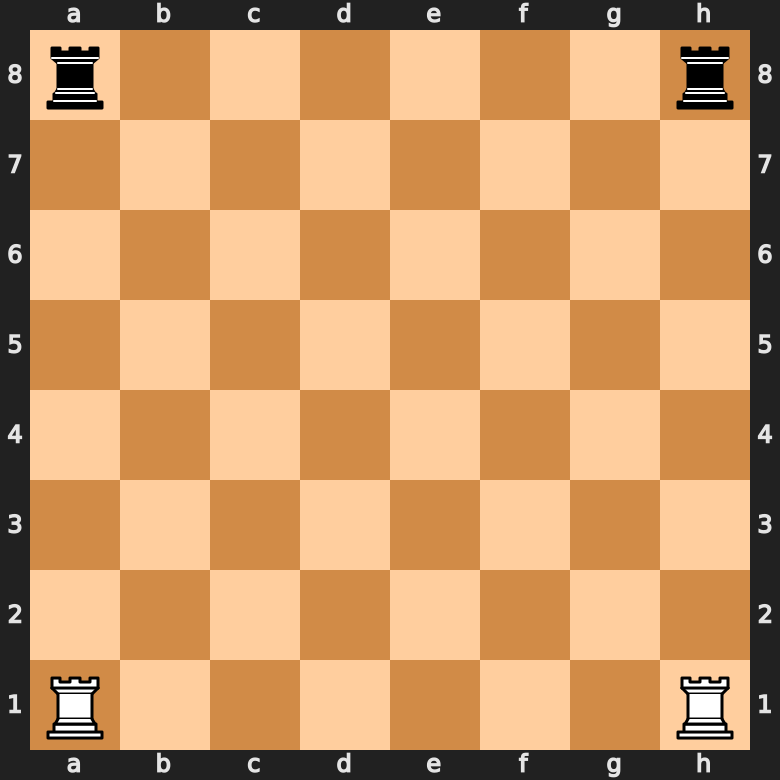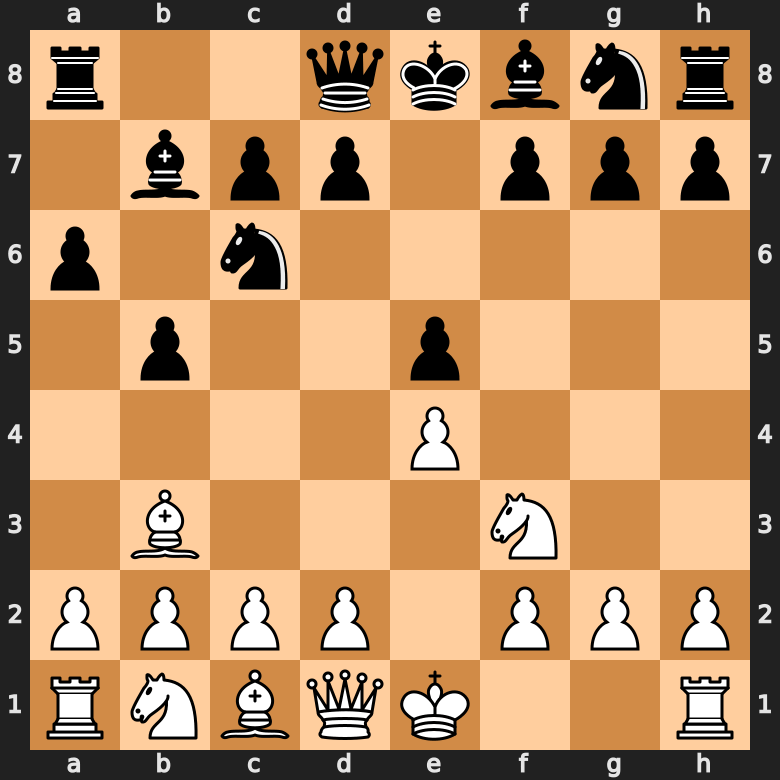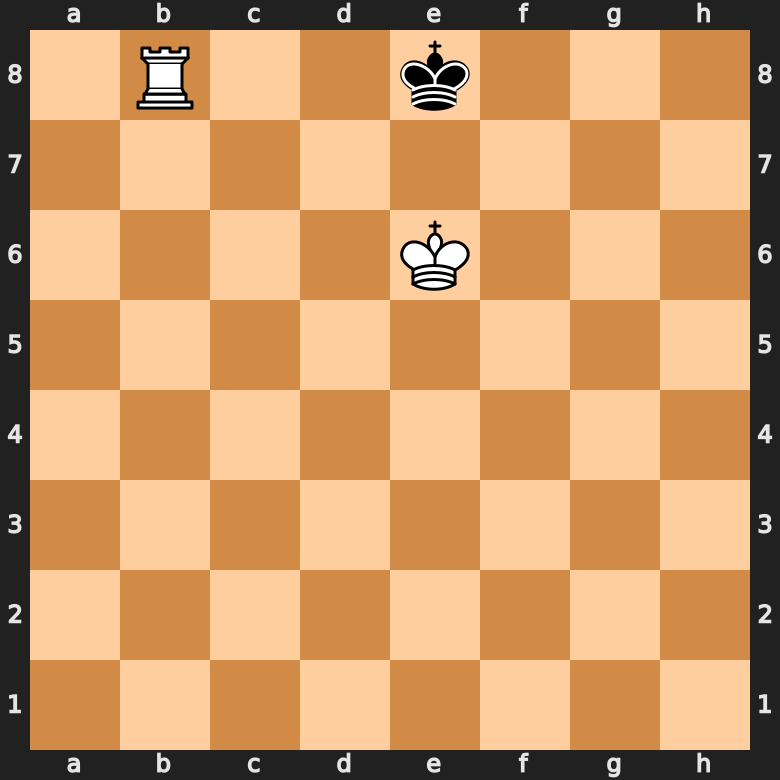The Rook in Chess ♖: Exhaustive Guide
The rook (sometimes incorrectly called the tower) is a major piece in the game of chess. Let’s do a deep-dive into the rook in chess.
Position of the Rooks on the Board
In total, there are four rooks in the game of chess. Both players start the game with two rooks, which are placed in the corners of the board. The two white rooks start the game on squares a1 and h1, while the two black rooks start the game in the opposite corners on a8 and h8:

In the starting position a rook is surrounded by a knight and two pawns. Due to their position in the corners, the rooks are heavily restricted in their movement by other friendly pieces.
How Does the Rook Move in Chess
Luckily, the movement of the rook in chess is quite straight-forward. It can move any number of unoccupied squares both horizontally or vertically. The rook cannot jump over other pieces. You can see the movement of the rook animated here:

In addition to its regular vertical and horizontal movement, the rook can participate in castling 🏰, a move that is done together with the king. We’ll look into castling a bit later in this guide; alternatively, you can find our full guide on castling here.
Important Information on the Rook
The rook is considered a major piece, alongside the queen. When noting your chess moves, the rook is indicated with the letter R.
Rook – How Much is it Worth (Value)?
The rook is the second most valuable piece in chess. Its relative value is said to be about 5 pawns. Obviously, the value the rook has in a particular game depends highly on its position. There are instances where a well-placed rook can be worth more than a queen 🤯.
Rook Strategy
Starting in the corners of the chess board, the rook is completely blocked by other friendly pieces. For that reason, the rooks are often the last pieces to get developed 🐢.
The usual procedure for rook development looks something likes this:
- Castle either king-side or queen-side
- Clear all other pieces from the back rank (except the king)
- Move one or both rooks to open files, if there are any
This way, both rooks are defending each other, a construct known as connected rooks.
Place Rooks on (Semi-) Open Files
A main goal of rook development is to place at least one (preferably both) rooks on (semi-) open files. This way, they can make use of their long-range movement capabilities and attack deeply into the enemy camp.

As you can see, the white rook can freely move along the open d-file, even moving deep into enemy territory. The black rook, on the other hand, is quite limited in its movement. Even though white is down on material in this case, the well-placed rook allows white to secure a draw in this position.
Rooks on the Seventh/Second Rank Are Powerful
Especially in the middle– and endgame, rooks can become a very important strategic resource, by placing them on the seventh rank (or the opponents second rank), like this:

In this case, black has two connected rooks on whites second rank.
Castling with Rook and King
The only special move that the rook can engage in, is castling. Castling involves moving both the king and rook simultaneously, which is why castling is also known as a “double move” in chess.
The main goal of castling is to activate and develop the rook, while protecting the king behind a wall of pawns. This is how castling looks in game:

There are four preconditions that need to be met, to be allowed to castle:
- The king and (castling) rook have not yet moved in the game.
- The king is not currently in check.
- No square the king would castle through are under attack.
- The squares between king and rook are unoccupied
If all requirements are met, you can castle your rook and king. So let’s look at how to castle:
- The king moves two squares towards the rook.
- The rook jumps over the king and gets placed directly next to it.
You can castle in two different directions; you can decide between a long and short castle.
- short castle / king-side castle: Performed between the king and rook on the h-file.
- long castle / queen-side castle: Performed by the king and rook on the a-file.
Rooks in the Endgame
Rooks play an important role in the endgame, as they are often the only major piece that is still on the board in the later phases of the game. Also, they become increasingly stronger 💪 in the endgame, when their movement is less restricted by enemy pawns and pieces.
Rooks are also a central component to a lot of different checkmating patterns in the endgame. For example, the king and rook checkmate:

Here are a few other checkmating patterns you should know for rook endgames:
- Two-rook checkmate (i. e. ladder checkmate)
- King and rook checkmate
- Back rank checkmate
3 Tips for Using the Rook Optimally
- Castle Early to Develop At Least One Rook Quickly
- Place Your Rooks on the second/seventh rank
- Learn Common Rook-Endgames
Rook – Frequently Asked Questions
- How Does the Rook Move in Chess?The rook can move any number of unoccupied squares in any horizontal or vertical direction.
- Can the Rook Move Backwards?Yes, the rook is allowed to move backwards.
- Can the Rook Jump Over Other Pieces?No, the rook cannot jump over other pieces – neither friendly nor enemy.
- How Many Pawns is the Rook Worth?The rook is said to be worth about five pawns. He does, however, increase in value during the endgame, where his movement is less restricted by pawns and other pieces.
- Can You Checkmate with a Rook?Yes, it is possible to checkmate with just a rook and your own king, as long as the enemy king doesn't have sufficient protection. In an endgame against a lone enemy king, a checkmate with king and rook can be forced.

